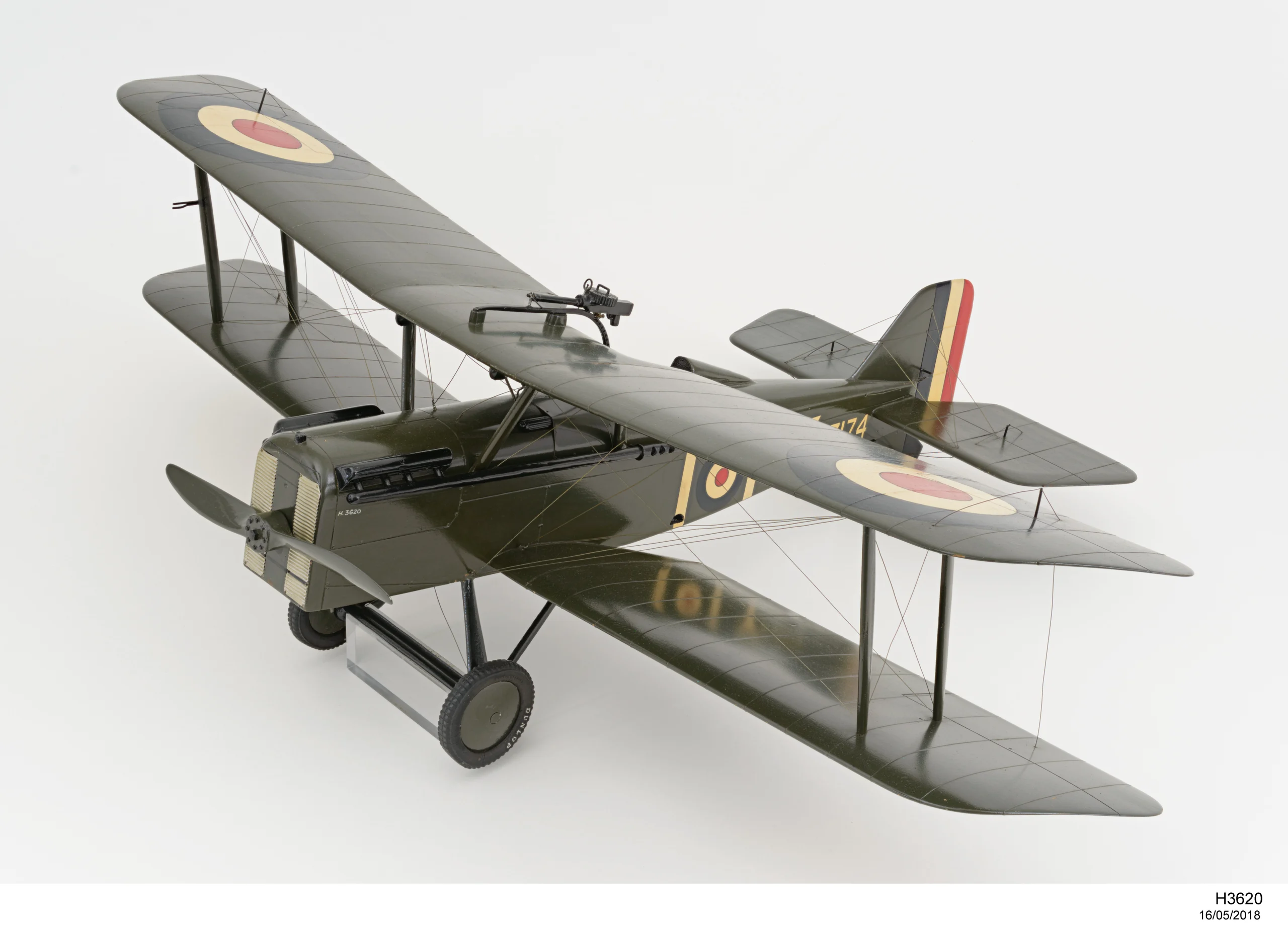
Physical Description
Single engine biplane with tailskid undercarriage. Lower wing passes through lower fuselage; upper wing supported on cabane struts and outer wing struts, wire braced. Ailerons marked out on both upper and lower wings. Pitot/static tubes fitted to RH forward outer strut. An Aldis gunsight is fitted to the upper cowling forward of the cockpit. 'Dunlop' rubber tyres are fitted to the mainwheels. A Lewis machine gun fixed to a Foster mounting is fitted to the upper wing centre. The model is painted dark green all over with silver radiator shutters and black engine rocker covers and exhaust pipes. The Lewis gun and cockpit coaming are also painted black. The British national colours of red, white and blue are painted on the rudder, and the red, white and blue roundels are painted on the aft fuselage sides and the top of the upper wing and the bottom of the lower wing. The serial number 'F7174' is painted in white on the aft fuselage sides and the squadron letter 'Y' is painted in white on the aft fuselage sides between the roundel and the serial. Two white vertical stripes are painted immediately before and after the fuselage roundels. The serial 'F7174' was not carried by an SE5A although it was allocated in 1918. It was allocated to an Airco DH10 bomber to be built by the Alliance Aeroplane Co. Ltd., although there is no delivery record for this aircraft.
The two vertical white stripes on the aft fuselage sides suggest that the modeller was basing the marking scheme on a 24 Squadron, RAF aircraft although the scheme is not considered accurate. The squadron letter 'Y' would have appeared on the top of the starboard wing and the serial number may have been repeated on the rudder. It is also possible that the undersides of the wings would not have been painted in the dark green as it was common practice to leave these surfaces as clear doped fabric giving the appearance of a buff colour.
Object Statement
The model was made by Mr Eric G. "Buster" Noble and John K Newton to a Museum commission. The origin of the design for this model is unknown as its serial number is erroneous and the markings generally suspect.
The model was made by Messrs. Eric G "Buster" Noble and John K Newton operating under the trade name "Newble". Newton and Noble made models professionally for Sir Charles Kingsford Smith, New England Airways, C A Butler, RAAF, Nestles, MIlton Kent and Mobil as well as the museum.
Production
The maker is George Oliver Ingledew (died 1954), 56 Park Road, Burwood, New South Wales.
Dimensions
- Height: 290 mm
- Width: 900 mm
- Depth: 660 mm
History
In 1916 the Royal Flying Corps issued a call to the British aircraft industry to produce a fighter that was superior to the contemporary German fighters.The SE5 (Scout Experimental 5) designed at the Royal Aircraft Factory, Farnborough, began service with No. 56 squadron in March 1917 and deployed to combat in France in April 1917. Arriving during "Bloody April" when many British fighters had been destroyed by superior German aircraft, the SE5s proved their worth in reclaiming the French skies.
The SE5 was one of the fastest aircraft of the war (222km/hr), manoeuvrable and stable. It proved to be underpowered, so its 112 kW engine was replaced in the SE5A by a geared 149 kW Hispano-Suiza 8b V8 engine or a 149 kW Wolseley Viper piston engine, and the new 5A model first saw service in June 1917. In all, 5265 SE5s were built, all but 77 in the 5A configuration. The SE5A proved to be the best operational fighter in the sky from late 1917 until the end of the war. Many of the top Allied aces flew this type of fighter, including Billy Bishop, Andrew Beauchamp-Proctor, Edward Mannock and James McCudden. McCudden wrote of the SE5: "It was very fine to be in a machine that was faster than the Huns, and to know that one could run away just as things got too hot ".